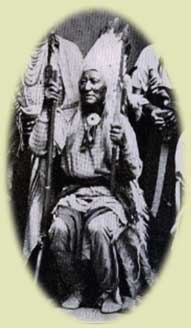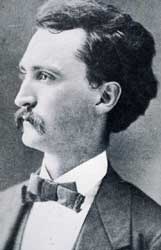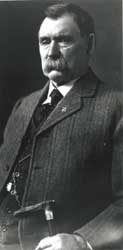|
Emigrants using the Bridger Trail
route suffered little from Indian attacks, although some theft
of stock by the Crow or Shoshoni was likely if the opportunity
presented itself. Several of the diaries tell of peaceful encounters
with small groups of different tribal identities, sometimes for
trading purposes along the trail. The route west of the Bighorn
Mountains and through the Bighorn Basin offered safety from the
marauding Sioux. However, once the trail joined with the Bozeman
route near the Rock Creek crossing south of the Yellowstone River,
the chance of Indian attack increased, although it was not as
prevalent as in the Powder River country.
Bridger guided the first train departing
from Red Buttes on May 20, 1864. Reverend L. B. Stateler accompanied
the train and spoke of their only encounter with Indians along
the trail. At one of their camps before reaching the Bighorn River,
probably in the upper Kirby Creek drainage, Stateler noted that:
"Next morning, to our astonishment,
we found that we were within a mile of a large
 band
of Indians who were camped on the creek below us. They had come
in during the night. We thought they were hostile Sioux. . . .
Major Bridger . . . went with a small company of unarmed men .
. . to obtain an interview with them. The chief . . . came with
a company of his braves . . . to meet them. Presently the Indians
changed their manner, began to shout Bridger! Bridger! . . . and
came galloping up. . . . They were Shoshoni, or Snake, Indians
from about old Fort Bridger, and recognized our captain as their
old friend. They had come across the mountains on a buffalo hunt.
The chief was a particular friend of Bridger. . . . The chief's
name was Wash-a-kie. This was the only Indian scare we had on
the journey." band
of Indians who were camped on the creek below us. They had come
in during the night. We thought they were hostile Sioux. . . .
Major Bridger . . . went with a small company of unarmed men .
. . to obtain an interview with them. The chief . . . came with
a company of his braves . . . to meet them. Presently the Indians
changed their manner, began to shout Bridger! Bridger! . . . and
came galloping up. . . . They were Shoshoni, or Snake, Indians
from about old Fort Bridger, and recognized our captain as their
old friend. They had come across the mountains on a buffalo hunt.
The chief was a particular friend of Bridger. . . . The chief's
name was Wash-a-kie. This was the only Indian scare we had on
the journey."
Howard Stanfield was in the second large train following Bridger's.
His party had left Red Buttes on May 30, guided by  John
Jacobs. His train saw no Indians until they were north of the
Shoshone River and exiting the Bighorn Basin through Pryor Gap.
"Our train saw but very few Indians not over fifty on the
whole route and they were as polite and civil as it is possible
for the sons of the forest to be in their own native home they
were of the Flathead tribe." Stanfield's train met the Flathead
along the upper portion of Sage Creek near Pryor Gap on June 21.
"[W]e stoped [sic] at noon and while there we were visited
by about thirty friendly FlatHead Indians both men and women they
are the first we have seen since we started on the cut-off. .
. . they were the most polite Indians we have seen upon the route
they do not beg or steal if you offer them of course they will
take it." John
Jacobs. His train saw no Indians until they were north of the
Shoshone River and exiting the Bighorn Basin through Pryor Gap.
"Our train saw but very few Indians not over fifty on the
whole route and they were as polite and civil as it is possible
for the sons of the forest to be in their own native home they
were of the Flathead tribe." Stanfield's train met the Flathead
along the upper portion of Sage Creek near Pryor Gap on June 21.
"[W]e stoped [sic] at noon and while there we were visited
by about thirty friendly FlatHead Indians both men and women they
are the first we have seen since we started on the cut-off. .
. . they were the most polite Indians we have seen upon the route
they do not beg or steal if you offer them of course they will
take it."
Robert Vaughn, a member of Joseph Knight's train, recalled passing
a large Sioux encampment with no adverse effect. He failed, however,
to provide the location of the camp.
"One day we came through a Sioux
village of eighty-five tepees; there were from two to three hundred Indians, chiefly women and children. On a slope
of a hill near by were eight hundred horses in charge of six Indians.
Though we camped at noon but a short distance from them, only
two approached us, and their actions were different from those
of the other Indians whom we had met. When the Sioux came to our
camp they would go from one tent or wagon to another in a sullen
manner with a contemptible look as if they were going to massacre
every one of us, and likely the reason they did not was that we
had taken them unawares and before they had time to prepare, besides
we were as good as an equal number of soldiers if it had come
to fighting."
to three hundred Indians, chiefly women and children. On a slope
of a hill near by were eight hundred horses in charge of six Indians.
Though we camped at noon but a short distance from them, only
two approached us, and their actions were different from those
of the other Indians whom we had met. When the Sioux came to our
camp they would go from one tent or wagon to another in a sullen
manner with a contemptible look as if they were going to massacre
every one of us, and likely the reason they did not was that we
had taken them unawares and before they had time to prepare, besides
we were as good as an equal number of soldiers if it had come
to fighting."
Vaughn's train also encountered a
party of Crow while traveling through the Yellowstone River Valley.
Except for their renown as expert horse thieves, the Crow were
friendly toward Euro-Americans in general. Vaughn remembered that
a party of mounted Indians rode up to the train, at which time
Captain Knight ordered the train to circle up and form a stockade.
"They were eighty-five in number . . . the chief came forward
and stated that they were 'Crows' and he wished to know who we
were and where we were going . . . They were mounted on good horses
and had on their war paint and all were stripped to their waists.
We gave them some bread and coffee and took a smoke with them
. . . They all left very peaceably and never came back. They were
the last Indians we saw until we got to Alder Creek."
Two trains, traveling several weeks behind Bridger's outfit, encountered
parties of Sioux and Crow along Clarks Fork of the Yellowstone
River in southern Montana. Charles Baker and William Atchison
were traveling three or four days ahead of William Haskell's train.
Both trains encountered Indians while camped along the river.
 Atchison's diary provides a much more detailed account of the
contact than Baker's. He noted on July 11, that "Some of
our `Red Skin' brethren of the `Crow' nation camped with us,"
a fact Baker failed to mention. On July 12, Baker noted that a
"great many Indians came to our camp at noon. . . ."
A much clearer picture emerges from Atchison's diary entry for
the same day. "Here a party of 200 Crow Indians came into
the camp for the purpose of trading. We made some excellent trades,
- robes, moccasins, etc."
Atchison's diary provides a much more detailed account of the
contact than Baker's. He noted on July 11, that "Some of
our `Red Skin' brethren of the `Crow' nation camped with us,"
a fact Baker failed to mention. On July 12, Baker noted that a
"great many Indians came to our camp at noon. . . ."
A much clearer picture emerges from Atchison's diary entry for
the same day. "Here a party of 200 Crow Indians came into
the camp for the purpose of trading. We made some excellent trades,
- robes, moccasins, etc."
Baker and Atchison's encounter with
the Crow was much more favorable and profitable than Haskell's
train, who undoubtedly experienced some trepidation while camped
a few days later. Haskell wrote
that on July 16, they "[C]ame onto a large party of Sioux
Indians. . . . had no trouble otherwise than that; had to camp
on Clarkes' Fork."
When Baker's train reached the Yellowstone
River a few days later on July 19, they laid over and a party
of prospectors sortied out into the foothills of the Absaroka
Mountain range. Baker is almost mute in his diary about Indian
contact, he simply, "saw Indians"; Atchison, however,
wrote that the train "Laid over for the purpose of prospecting
. . . About 30 men went out . . . Prospecting party in ascending
a deep gulch were met by a party of six hundred Indians and driven
back. Thus ends, for the present, prospecting on the Yellow Stone."
There is no reference to which tribe chased the prospectors out
of the gulch. Due to their recent peaceful contact with the Crow,
it seems that it may have been the Sioux, or possibly the Blackfeet.
Almost two weeks later Haskell's
train was moving slowly along the Yellowstone River to allow prospecting
parties to inspect the nearby mountains for signs of gold. On
July 29, his train "Drove ten miles up the Yellowstone and
found our party awaiting us; wanted more men, too many Indians
to venture [safely]; reinforced them with 12 men; the camp has
been thronged all day by Crow Indians; they are infernal beggars."
No doubt from their perspective, the Crow felt justified in exacting
some kind of payment from Haskell's train, and others, trespassing
through their territory, lands that had been theirs traditionally,
and part of which had been set aside for their occupation and
hunting grounds as stipulated in the 1851 Fort Laramie Treaty.
In fact the following spring of 1865,
the Crow, frustrated by the continued crush of emigration to Montana
and the constant harassment of the Sioux, expressed a desire to
sell the entire Yellowstone River Valley and go on a reservation,
preferably near the mouth of the Yellowstone. According to Mahlon
Wilkinson, Indian Agent for the Upper Missouri, the Crow warned,
however, that "Col Bridger's road. . . as well as the proposed
roads from the Missouri river pass through their country and should
no treaties be made and their present annual supply of goods be
stopped hostilities must be the result the Assinniboine would
Surely join them."
Perhaps the most noteworthy account
of Indian encounters by a Bridger Trail emigrant may be that of
Tom LeForge. He was fourteen when traveling with his parents on
the trail in the spring of 1864, bound for Virginia City, Montana.
No date is given for their departure from Red Buttes, but he did
write that "our train was not far behind one that was led
by Jim Bridger as its guide." It is possible that LeForge's
party was part of the ten wagons that made up the party of Independents
that followed behind Jim Bridger's lead train. LeForge and his
family had two wagons and traveled with traders Gus Beauvais and
one Mollette from St. Joseph. While still on the South Platte,
LeForge recalled, "Hostile Indians killed people ahead of
us and behind us, but we did not lose any members of our party
in this way. We attributed our good fortune to the presence of
Beauvais and Mollette. . . . A band of Sioux visited us. . . .
Mollette knew some of them personally." A war party of Sioux
visited LeForge's train after they crossed the North Platte River
and warned against traveling through the Powder River Basin. "They
. . . made sign-talk with Beauvais and Mollette. . . . if we would
go by the `Blanket Road', the Sioux would not annoy us. `Blanket'
was their name for Jim Bridger. . . . We traveled the Bridger
Road. . . . [Still, LeForge stated that] we had some minor attacks
by Indians. One night our night herders were shot at . . . about
noon one day a war-party appeared off on a hill to our right.
. . . During the entire journey every man kept himself armed and
ready for trouble."
The first fatalities occurred on
the last leg of the trip, when LeForge's train was near the Shields
River east of present-day Livingston, Montana. A preacher traveling
with the train "protested against the dancing, but with no
avail. . . . he became so distressed by . . . the incorrigible
wickedness of the company that he announced his determination
to go back. The next day he did so, taking with him his son. But
they did not go far. News came to us in a few days that their
dead and mangled bodies had been found along the trail. Hostile
Indians . . . had pounced upon them as easy prey."
The Indians responsible for the death
of the preacher may have been Blackfeet or possibly Sioux ranging
west of the Powder River country and the Bighorn River. Although
the train was traveling through a region claimed by the Blackfeet
and Crow, it was unlikely that they were Crow. Prior to the death
of the preacher and his son, a man named Adams had stayed behind
when LeForge's train departed the Stillwater River, several days
drive east of the Shields River. "His three wagons were loaded
with merchant goods, including a rich cargo of silks." The
train was camped on the Yellowstone when Adams returned on foot
claiming his wife had been killed by Indians.
A body of men accompanied Adams back
to search for his wife. They found her tracks by a creek. . .
. They found her, very tired and very hungry, but not injured.
They then sought the wagons. These they found guarded by a few
Crow Indians. . . . the supposed "attack" was by friendly
Crow Indians. In the course of their visit . . . one of them playfully
displayed his hunting knife. Either Adams or his helper fired
a shot that killed this Indian, Sorrel Horse. Then the three whites
scattered . . . to get away, with the Crows following after them
in an effort to assure them of good intentions. At their request,
Adams now gave them presents from his stock, these to compensate
them for killing their companion.
LeForge spoke of one final encounter
with Indians before his train reached its destination in Montana.
"We met a band of Nez Perces on the upper Yellowstone River.
They had come over the Rocky Mountains to hunt buffalo in the
Crow country, they being friendly with the Crows and both tribes
being on good terms with the whites. In this band was an Indian
from some tribe in Kansas who had married a Nez Perces woman.
. . . My father had known him in Kansas, had served with him in
the army, and this renewal of acquaintance helped greatly to ease
our minds as to possible Indian trouble."
|
 |